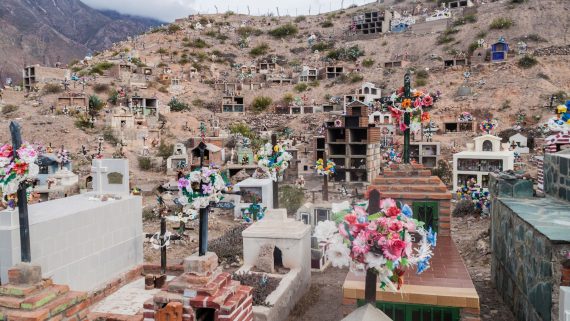Before talking about the treatment that is given to the subject of death in Latin America, it is necessary to contextualize the information by mentioning the role of religion within the Hispanic American culture, since the majority of the population professes Catholic Christianity. Below we list the main acts or rituals related to death in Latin America.
Below you have an index with all the points that we are going to deal with in this article.
Article Index
- 1.
- 2.
- 3.
- 4.
- 5.
- 6.
Prayer of the Novena
In the first place, it is worth highlighting the prayer of La Novena, which is common to all countries of Latin America, since it encompasses a series of shared knowledge within this society.
Within the worldview of Hispanic-American culture, the number nine is a symbol of multiplicity that returns to unity, perfection and redemption.
When a loved one dies, it is believed that the soul remains around the corpse for nine days until it begins its final journey. For this reason, every night during the nine days after the death, the Novena is said at the deceased's house, where the participants in turn celebrate a banquet.
According to the DRAE (Dictionary of the Royal Spanish Academy), "the Novena is an institutionalized religious practice that is practiced for nine days with prayers, readings, litanies and other pious acts, directed to God, the Virgin and the saints" . Thus, the prayer of the Novena responds to feelings of anguish and need.
Helped by the Novena, people try to overcome the tragedy and make a festive reenactment. It is believed that divine potency can act in favor of man.
Argentina, Venezuela and Paraguay
In these countries, the wake lasts 24 hours and is done in this way because, according to the natives themselves, "San Pedro does not wait." Although it is sometimes celebrated in a funeral home, it is usually celebrated at the deceased's home and the deceased is lying in his own bed.
Wakes are moments of reunion not only family, but also of all friends and relatives. Therefore, they are places where stories are heard, anecdotes are told, comments are made on politics and economics, cards are played and even jokes are told.
Relatives and neighbors come en masse and prayer shifts are organized that combine prayers themselves with religious songs. At the same time, the owners of the house organize a lavish banquet.
The next day the burial is celebrated, in which the whole town goes in procession to the cemetery. Depending on the social class to which the deceased belonged, classes and all kinds of social activity may be suspended.
After the burial, the entire cemetery is swept and, on some occasions, coca leaves are thrown into the grave. For the first few days after burial, flowers are brought to the grave daily or weekly.
Guatemala
Guatemala is a multicultural and multilingual country, so it has different myths and customs that vary according to areas.
The Guatemalan family is characterized by maintaining a strong union in any circumstance, so that when a member passes away, they all work together to make preparations for the wake of the deceased.
During the wake, in some regions chocolate is offered to soups or sandwiches and the participants remember anecdotes of the deceased; in other areas, the entire town spends the night smoking, drinking rum, and playing cards, especially poker.
The wake can last up to 72 hours. The next day, before moving the coffin to the cemetery, a present body mass in the church. Walking behind the coffin, they sometimes accompany mariachi bands.
Peru
Since ancient times, Peruvians have had a lot of respect for the deceased and the idea is common that, if someone dies, this is a offering for God and, therefore, a ceremony has to be held in this situation.
In Peru, for ideological reasons, there are differences between the better-off classes and those with low resources. This responds to ideological reasons, according to which society has acquired certain cultural habits and praxis that contribute to the hierarchy and / or discrimination of different social groups within this same culture.
In the case of a low-income family, the wake is held at the deceased's home and they are buried on their property after having performed a mass with the village priest.
When the economic position is greater, depending on the importance of the deceased in life, the wake can be extended up to three days and, during the trip to the cemetery, the places of the town where he spent the most important moments of his life are visited.
Ecuador and Bolivia
In Ecuador and Bolivia, when a relative dies, it is a very common practice for them to bathe and dress them in their best clothes and to be buried next to their most precious objects.
Usually the funeral lasts two days in which food and drink are offered to those present. On the third day the funeral is celebrated, in which everyone dresses in black. Family members must stay in mourning for a year.
In some indigenous peoples, especially those in eastern Ecuador, a shaman performs a ritual postmortem with herbs and flowers.
Afterwards, the deceased is placed on a raft in the water and, while the town celebrates a festival in honor of the deceased, his body is burned. At the end, the remains of the raft are collected and buried.
Communicate death
The diversity of beliefs, rites, devotions and celebrations in case of death that take place in Latin America corresponds to a collective way of seeing the world, in which the welfare of the group prevails over that of the individual. The worth of an individual lies in how he has contributed in life to society.
This collectivist worldview would clash with existing individualism, for example, in North American culture, in which great importance is attached to the individual, that is, the autonomy of individual beings is valued.
This collectivism can be reflected when communicating death. So when it comes to give condolences or speak directly about the subject with a direct relative of the deceased, it is usually based on the hypothesis that we share a wide range of information with our interlocutor.
In this way, statements of the type are usually used:
- My deepest condolences
- So sorry
- I express my condolence
- I accompany him in his pain
To show concern for the emotional state in which the deceased's relative is, the expression is often used What was there? or just wonder How are you? or other similar forms.
On most occasions when condolences are offered, the recipient's usual response is silence. However, this silence hides a series of implicatures through which more is said than meets the eye: it responds to an end and, in this case, it is about showing the sender the pain that is suffered.
Normally, the expressions mentioned above are accompanied by a non-verbal greeting, which varies depending on whether the person giving it is a man or a woman. Among men, the characteristic is to pat on the shoulder.
On the other hand, between women or between men and women, condolences are usually accompanied by a kiss on the cheek, perhaps because there is more respect for the female gender. This greater respect could be explained from the concept of "courtesy" in the sense of "chivalry" or "ceremonious courtesy."
This article has been shared 29 times. We have spent many hours collecting this information. If you liked it, share it, please:








